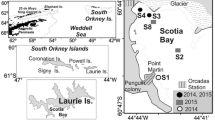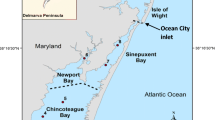Abstract
Copepods play an important role in marine ecosystems as key prey species of important commercial fishes. However, there is very limited data for the Seto Inland Sea, especially after the late 1990s. In the present study, we described the abundance and biomass of copepods over a 3-year period in Harima-Nada, eastern Seto Inland Sea, Japan. In Harima-Nada, the dominant species were Paracalanus spp., Oithona spp., and Microsetella spp. by abundance of both nauplii and copepodites. In terms of biomass, Paracalanus spp. and Microsetella spp. dominated with Calanus sinicus instead of Oithona spp. Copepod adult assemblages based on body carbon weight were classified into three seasonal clusters. The representative species of each cluster were Microsetella norvegica, Paracalanus parvus s.l., and C. sinicus for groups 1, 2, and 3, respectively. It was considered that the copepod nauplii densities of Harima-Nada are insufficient to saturate the survival rate of Japanese anchovy larvae. The biomass of dominant copepods seems to be almost the same as previous studies, but C. sinicus, which is representative of group 3 and an important prey item for the sand lance, is expected to become more unstable in the future.








Similar content being viewed by others
References
Anderson MJ (2001) A new method for non-parametric multivariate analysis of variance. Aust Ecol 26:32–46
Bray JR, Curtis JT (1957) An ordination of the upland forest communities of southern Wisconsin. Ecol Monogr 27:325–349
Downing JA, Plante C, Lalonde S (1990) Fish production correlated with primary productivity, not the morphoedaphic index. Can J Fish Aquat Sci 47:1929–1936
Dufrene M, Legendre P (1997) Species assemblages and indicator species: the need for a flexible asymmetrical approach. Ecol Monogr 67:345–366
Fujita T, Yamamoto M, Kono N, Tomiyama T, Sugimatsu K, Yoneda M (2021) Temporal variations in hatch date and early survival of Japanese anchovy (Engraulis japonicus) in response to environmental factors in the central Seto Inland Sea, Japan. Fish Oceanogr 30:527–541
Fujiwara T, Higuchi K, Fujii T (2020) Minimum nutrient concentrations for sustaining marine ecosystem productivity: measurement during in situ growth experiments of bivalve and sessile organisms. J Jpn Soc Water Environ 43:175–182 (in Japanese with English abstract)
Fujiwara T, Suzuki K, Kimura N, Suzuki M, Nakajima M, Tadokoro K, Abo K (2022) Impact of variation in nutrient concentration on ecosystem, biomass, and production in a semi-enclosed embayment: Osaka Bay. J Jpn Soc Water Environ 45:145–158 (in Japanese with English abstract)
Hashiguchi S, Nishikawa T, Uozumi K, Furusawa K, Mori A, Imao K, Tanda M (2021) Causal factors of interannual decrease in stomach content index (SCI) of juvenile western sand lance Ammodytes japonicus in Harima-Nada, eastern Seto Inland Sea, Japan. Bull Jpn Soc Fish Oceanogr 85:24–32 (in Japanese with English abstract)
Hirota R (1968) Zooplankton investigations in the Setonaikai (Inland Sea of Japan), II. Occurrence zooplankton in the eastern half of the Setonaikai in September, 1963. J Oceanogr Soc Japan 24:212–219
Holm-Hansen O, Lorenzen CJ, Holmes RW, Strickland JDH (1965) Fluorometric determination of chlorophyll. J Cons Int Explor Mer 30:3–15
Imai I, Yamaguchi M, Hori Y (2006) Eutrophication and occurrences of harmful algal blooms in the Seto Inland Sea, Japan. Plankton Benthos Res 1:71–84
Itoh H, Aoki N (2010) Temporal and spatial distribution of planktonic copepods in Tokyo Bay: seasonal occurrence in the innermost part of the bay, in the early 1990s. Bull Plankton Soc Japan 57:94–104 (in Japanese with English abstract)
Kobari T, Hosouchi S, Mori H, Ota H, Fukada R, Uchiyama M (2015) Seasonal variations in the population structure and depth distribution of Calanus sinicus in northern Kagoshima Bay. La Mer 53:61–71
Kobayashi S, Simpson JH, Fujiwara T, Horsburgh KJ (2006) Tidal stirring and its impact on water column stability and property distributions in a semi-enclosed shelf sea (Seto Inland Sea, Japan). Continental Shelf Res 26:1295–1306
Koga F (1987) The occurrence properties, biomass and production of zooplankton in Osaka Bay, eastern Seto Inland Sea. Bull Seikai Res Lab 64:47–66 (in Japanese with English abstract)
Legendre P, Gallagher ED (2001) Ecologically meaningful transformations for ordination of species data. Oecologia 129:271–280
Manabe T, Tanda M (1985) The method for water sampling of bottom layer in Inland Sea. Bull Japan Soc Sci Fish 51:1745 (in Japanese)
McQueen DJ, Johannes MRS, Post JR (1989) Bottom-up and top-down impacts on freshwater pelagic community structure. Ecol Monogr 59:289–309
Mitsuzawa A, Miyamoto H, Ueda H (2017) Feeding selectivity of early-stage fish larvae on the nauplii and eggs of different copepod species. Plankton Benthos Res 12:115–122
Nishikawa T, Hori Y, Nagai S, Miyahara K, Nakamura Y, Harada K, Tanda M, Manabe T, Tada K (2010) Nutrient and phytoplankton dynamics in Harima-Nada, eastern Seto Inland Sea, Japan during a 35-year period from 1973 to 2007. Estuaries Coasts 33:417–427
Nishikawa T, Hori Y, Nagai S, Miyahara K, Nakamura Y, Harada K, Tada K, Imai I (2014) Long-term (36-year) observations on the dynamics of the fish-killing raphidophyte Chattonella in Harima-Nada, eastern Seto Inland Sea, Japan. J Oceanogr 70:153–164
Nishikawa T, Nakamura Y, Okamoto S, Ueda H (2020) Interannual decrease in condition factor of the western sand lance Ammodytes japonicus in Japan in the last decade: Evidence for food-limited decline of the catch. Fish Oceanogr 29:52–55
Nixon SW (1982) Nutrient dynamics, primary production and fisheries yields of lagoons. Oceanol Acta, pp 357–371
Nonomura T, Machida RJ, Nishida S (2008) Stage-V copepodites of Calanus sinicus and Calanus jashnovi (Copepoda: Calanoida) in mesopelagic zone of Sagami Bay as identified with genetic markers, with special reference to their vertical distribution. Progress Oceanogr 77:45–55
Okazaki Y, Tadokoro K, Kubota H, Kamimura Y, Hidaka K (2019) Dietary overlap and optimal prey environments of larval and juvenile sardine and anchovy in the mixed water region of the western North Pacific. Mar Ecol Prog Ser 630:149–160
Ueda H (1991) Horizontal distribution of planktonic copepods in inlet waters. Bull Plankton Soc Japan Spec 143–160
Uye S (1982) Length-weight relationship of important zooplankton from the Inland Sea of Japan. J Oceanogr Soc Japan 38:149–158
Uye S (2000) Why does Calanus sinicus prosper in the shelf ecosystem of the Northwest Pacific Ocean? ICES J Mar Sci 57:1850–1855
Uye S, Shimazu T (1997) Geographical and seasonal variations in abundance, biomass and estimated production rates of meso- and microzooplankton in the Inland Sea of Japan. J Oceanogr 53:529–538
Uye S, Aoto I, Onbe T (2002) Seasonal population dynamics and production of Microsetella norvegica, a widely distributed but little-studied marine planktonic harpacticoid copepod. J Plankton Res 24:143–153
Yamamoto T (2003) The Seto Inland Sea–eutrophic or oligotrophic? Mar Poll Bull 47:37–42
Yamamoto K (2005) Changes of environment and zooplankton in the Seto Inland Sea—a case of Osaka Bay. Aquabiology 158:222–229 (in Japanese with English abstract)
Yoshie N (2022) Current status and problems of the end-to-end model including processes from nutrient cycles to a higher-trophic-level marine ecosystem. Bull Coastal Oceanogr 60:41–50 (in Japanese with English abstract)
Zenitani H, Kono N, Tsukamoto Y (2007) Relationship between daily survival rates of larval Japanese anchovy (Engraulis japonicus) and concentrations of copepod nauplii in the Seto Inland Sea, Japan. Fish Oceanogr 16:473–478
Zenitani H, Kono N, Tsukamoto Y (2009) Effects of temperature, food availability, and body size on daily growth rate of Japanese anchovy Engraulis japonicus larvae in Hiuchi-nada. Fish Sci 75:1177–1188
Acknowledgements
We are grateful to emeritus professor Hiroshi Ueda of Kochi University for his valuable advice on our research. We also thank the captain and crew of the R/V Shin-Hyogo and researchers of the Fisheries Technology Institute, Hyogo Prefectural Technology Center for Agriculture, Forestry and Fisheries for their cooperation in sampling and measurement of water samples.
Author information
Authors and Affiliations
Corresponding author
Additional information
Publisher’s Note
Springer Nature remains neutral with regard to jurisdictional claims in published maps and institutional affiliations.
Supplementary Information
Below is the link to the electronic supplementary material.
Rights and permissions
Springer Nature or its licensor (e.g. a society or other partner) holds exclusive rights to this article under a publishing agreement with the author(s) or other rightsholder(s); author self-archiving of the accepted manuscript version of this article is solely governed by the terms of such publishing agreement and applicable law.
About this article
Cite this article
Nishikawa, T., Watanabe, T., Shiotani, T. et al. Seasonal copepod dynamics and biomass in Harima-Nada, eastern Seto Inland Sea, Japan. Fish Sci 89, 343–356 (2023). https://doi.org/10.1007/s12562-022-01659-1
Received:
Accepted:
Published:
Issue Date:
DOI: https://doi.org/10.1007/s12562-022-01659-1




